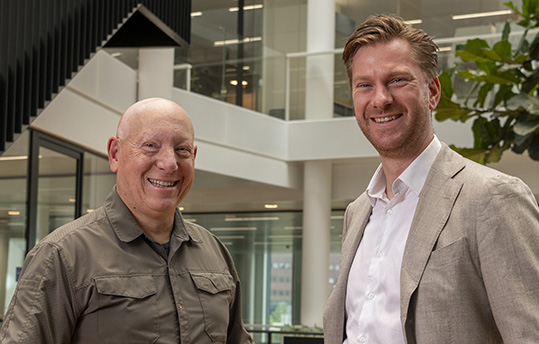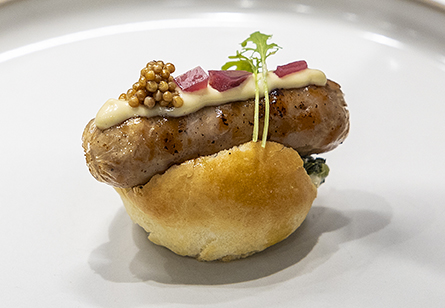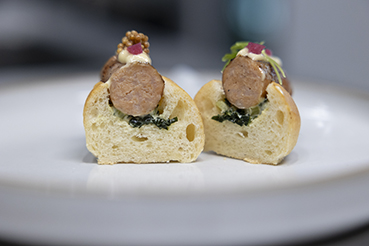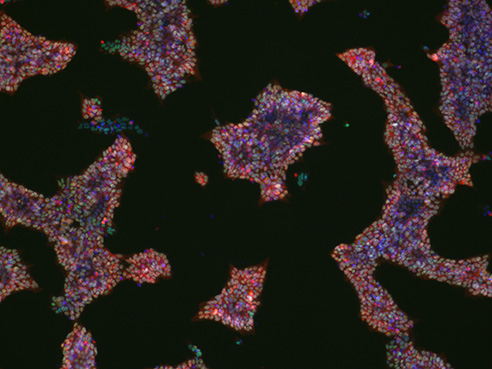

Protein Pioneer: Jeff Tripician
Jeff ‘Trip’ Tripician, a veteran of traditional meat and big ag, now champions a food revolution. Here, he unveils how Meatable’s leap in cell-based technology, fueled by strategic collaborations, is set to redefine protein production, promising a future of sustainable abundance
From the sprawling fields of traditional agriculture to the cutting-edge bioreactors of cell ag, Jeff ‘Trip’ Tripician’s journey has been nothing short of transformative. Now, at the helm of Meatable, the Dutch cultivated meat company, he’s charting a course that bridges the divide between established meat production and the emerging realm of cell-cultivated meat. With decades of experience navigating the complexities of the conventional meat sector, Tripician offers a unique perspective on the challenges and opportunities that lie ahead for cell-based meat.

His transition to cultivated meat wasn’t a sudden leap, but a gradual evolution, culminating in a pivotal moment of reflection. “The question that really struck me was: where will my grandchildren get their food?” Tripician says. “That was one of those moments where you look in the mirror and think – everyone expects someone else to tackle this. Why shouldn’t that someone be me?” This deeply personal motivation, coupled with a keen awareness of the mounting pressures on global food systems, propelled him to the forefront of a movement seeking sustainable solutions.
What is especially intriguing about Tripician is that his extensive background provides him with a valuable insight that many in the cultivated meat space lack: a profound understanding of the traditional meat industry’s intricate ecosystem. “There’s already a US$2 trillion global infrastructure, with more than 100 years of experience in taking meat from livestock, disassembling it, and turning it into edible products,” he says. As such, he believes the cultivated meat sector’s success hinges on collaboration, not confrontation. “Why wouldn’t you say, ‘Why don’t we work with them?’” he poses, advocating for a synergistic approach that leverages existing systems.
Tripician aims to correct a common misconception: that cultivated meat is meant to replace traditional agriculture. “It’s not meant to replace farmers or ranchers. That’s not realistic,” he asserts. Instead, he regards it as a complementary solution, providing meat companies with an alternative raw material to meet the escalating global demand for protein. “I’ve spent a lifetime supporting those people,” Tripician adds, emphasizing his commitment to the agricultural community. “They have a tough job.”
Bridging the gap
At the same time, he acknowledges skepticism within the conventional meat industry, largely due to unfamiliarity with the technology. “Right now, cultivated meat is a technology that meat companies spend zero time thinking about because they don’t fully understand what it is – and what it isn’t,” Tripician feels. That’s why he is very adamant on making clear that cultivated meat is not an alternative to meat. “It is meat,” Tripician insists. “It comes from animal cells, from an animal. It’s not plant-based, not soy, not an analog. It’s simply a different way of raising meat.”
From a business perspective, reducing production time by two-thirds is a major advantage. Compared to traditional livestock, which takes years, our process is 25 times faster
Hence he laments the use of labels such as ‘lab-grown’, which create a misleading perception. “Putting restrictive labels on it limits how people see it,” he argues. “It’s simply a different way of raising meat. You don’t need an animal walking around for years, consuming crops and water. We can do this in 12 days – from cell to plate.”

To address this knowledge gap, in February 2025, Meatable hosted an event for meat industry leaders, vendors, and government representatives. “We spent 12 hours discussing it,” Tripician reflects. “We let them taste the product, see how it behaves on a menu, how it performs in packaging, what it costs, and how it scales.” The response, he says with a smile, was overwhelmingly positive, with numerous meat companies expressing interest in further collaboration.
Meatable’s groundbreaking approach revolves around its proprietary Opti-Ox technology, which dramatically accelerates cellular growth. “While most cultivated meat takes about 45 days to produce, we do it in just 12 days,” Tripician says proudly. This efficiency translates to significant cost advantages, a critical factor in achieving price parity with conventional meat. “From a business perspective, reducing production time by two-thirds is a major advantage. Compared to traditional livestock, which takes years, our process is 25 times faster.”
The Meatable CEO, who joined the Dutch company in June 2024, emphasizes the importance of demystifying the science behind cultivated meat. “This process isn’t so different from any large piece of equipment in a conventional processing plant – it just operates at a much smaller level, starting with cells,” he explains. “But 12 days later, we have large volumes of cultivated meat that behave exactly like ground pork or ground beef.”
Meatable’s focus on pork as its initial product reflects its commitment to addressing global food security. “We started with pork because it’s a staple in large parts of the world, especially in regions concerned about food security,” Tripician continues. “Pork made sense as our starting point. But beef is right behind it.”
The path to price parity
Addressing concerns about the cost and energy intensity of cultivated meat, Tripician draws parallels with the early stages of other technological innovations. “In the beginning, it’s all about proof of concept,” he observes. “You need to ensure the product works, is safe, and can scale.” Meatable’s progress in reducing production costs, coupled with ongoing advancements in bioreactor technology, instills confidence that price competitiveness is within reach. “To date, Meatable’s production costs have dropped by 93%. That’s huge,” Tripician feels. “And by the end of the February 2025, we’ll have achieved a 98% reduction from where we started.”

Tripician predicts that Meatable will reach price parity with premium meats within the next three to four years. “At the end of that period, we’ll reach US$6.37 per pound, or about US$14 per kilo. At that price point, it’s comparable to premium meats – like organic options – making it a viable substitute,” he predicts. “It’ll take a bit more time and further scaling to reach true commodity pricing, but we’ll get there. We’re currently about US$1 away from that target.”
Tripician, who prior to joining Meatable was CEO of Grass Fed Foods, where he orchestrated a successful merger between Teton Waters Ranch and SunFed Ranch to position the company as one of the largest grass-fed beef platforms in the USA, also addresses the broader issue of supply chain resilience. “How do you handle livestock diseases? How do you manage global disruptions, whether due to conflict or extreme weather?” he asks. “These are serious questions because the lead time for livestock is significant.”
In terms of go-to-market, Tripician champions a hybrid approach, blending cultivated meat with plant-based ingredients or conventionally produced meat, as a practical pathway to consumer adoption. “You take a product consumers already buy and like, and then adjust the formula – replacing 25% of it with Meatable’s cultivated meat,” he explains.
“The cost is also diluted,” he adds. “Even if cultivated meat costs a bit more, making it only 25% of the formula means its impact on the final product’s price is negligible, while the taste remains identical.” Ultimately, Tripician sees this as a particularly attractive option for plant-based meat companies, which often struggle to replicate the taste of real meat.
Meatable’s business model is centered on strategic partnerships and licensing agreements. “Our model is different. We’re asset-light,” Tripician suggests. “We are a vendor to the meat industry, which has already deployed the necessary capital.” Such an approach allows the company to scale rapidly and efficiently, leveraging the existing infrastructure of established meat producers.
Navigating the future
The broader context of sustainability underscores the urgency for innovative protein solutions. “From a soil and water standpoint, we’ve degraded the planet’s ability to sustain current agricultural yields,” Tripician warns, citing alarming statistics on soil degradation and water scarcity. That’s why he views cultivated meat as a vital tool in alleviating pressure on strained natural resources. “There has to be another option – something that gives the land time to recover. Cultivated meat appears to be the best bet right now,” he feels.
No farmer or rancher, anywhere on this planet, will suffer because of cultivated meat – ours or anyone else’s
Overcoming consumer hesitancy will remain a key challenge, but Tripician believes that the younger generation’s embrace of technology will pave the way for acceptance. “They view technology as a solution to many challenges,” he suggests. “For them, it won’t be surprising that technology plays a role in solving the food system.” Additionally, taste remains a paramount consideration. “If I taste a product and think, I like that, or I can’t tell the difference, or even it tastes better, I’ll buy it, assuming it’s affordable,” he asserts.

Naturally, Tripician remains optimistic about the future of cultivated meat, despite regulatory hurdles and skepticism from some quarters. “I think that’s temporary,” he says, referring to state-level bans in the USA. “Reasonable people eventually win these arguments.” That opposition aside, he anticipates that Asia will lead the way in mainstream adoption, with products appearing in major food chains within the next five years.
Tripician’s leadership at Meatable reflects a pragmatic and forward-thinking approach, one that recognizes the need for collaboration, innovation, and a shared commitment to building a sustainable food future. With expertise in both traditional and emerging protein systems, Tripician positions Meatable as a key player in the evolving global food landscape. His vision extends beyond mere technological innovation; it encompasses a holistic understanding of the intricate web of factors that shape our food systems, from the economic realities of traditional agriculture to the pressing environmental concerns that demand urgent action.
The economic imperative
Moreover, his strategic approach to profitability underscores this comprehensive perspective. Rather than pursuing a capital-intensive, vertically integrated model, Meatable positions itself as a crucial vendor to the established meat industry. This model allows Meatable to leverage the existing infrastructure, distribution networks, and brand recognition of established meat producers, accelerating market penetration and minimizing financial risk.
“What we do is save them a decade’s worth of scientific development through a licensing model – almost like a franchise,” Tripician explains. “We provide them with the rights to produce our product under our guidance, with our lab personnel assisting in their plants. They simply incorporate it into their existing formulas.” This collaborative approach fosters a sense of partnership, transforming potential competitors into allies in the pursuit of a more sustainable protein future.
Meatable’s global expansion strategy is equally pragmatic. Recognizing the diverse regulatory landscapes and market dynamics across different regions, the company is establishing a network of regional hubs. “We’ve identified eight global business hubs that will activate at the right time – timing dictated by each country’s regulatory readiness,” Tripician reveals. This decentralized approach allows for flexibility and responsiveness, enabling Meatable to adapt its strategies to the specific needs and opportunities of each market.
The company’s focus on Asia, meanwhile, reflects the region’s burgeoning middle class, growing demand for protein, and progressive regulatory environments. “There’s
a vibrant hub of commerce developing in Asia as we speak,” Tripician observes. “Our next hub will likely be in the UK, given its favorable stance toward cultivated products and regulatory approval.” This strategic expansion positions Meatable to capitalize on the early adoption of cultivated meat in key markets, paving the way for wider acceptance.
A dialogue grounded in facts
Tripician accepts the naysayers that still exist within some segments of the conventional meat industry. “I’m not here to change anyone’s mind,” he states, before stressing the importance of open dialogue and fact-based discussions. “People are entitled to their own opinions – as long as those opinions are grounded in fact.” He addresses concerns about the potential impact of cultivated meat on farmers and ranchers, arguing that it can actually provide a buffer against the pressures of increasing demand. “If the meat market were static, then yes, cultivated meat could be seen as taking away from farmers and ranchers,” he concedes. “But that’s not the reality. The industry is projected to grow by 70% over the next 25 years.”
He stresses that the alternative to cultivated meat is not a return to a simpler, less intensive form of agriculture. Instead, it is a scenario in which farmers and ranchers are forced to push their land and livestock to their limits, exacerbating environmental degradation and compromising animal welfare. “Cultivated meat changes that dynamic,” he argues. “It gives farmers and ranchers breathing room. They don’t have to expand or push their land to the briThe regulatory landscape for cultivated meat remains complex and fragmented, with varying levels of acceptance and support across different jurisdictions. Tripician acknowledges the challenges posed by state-level bans in the USA, but remains optimistic that reason will prevail. “I think that’s temporary,” he says, expressing confidence in the power of the Interstate Commerce Act and the ultimate triumph of common sense. “We’ve just come through an election cycle with plenty of energy and strong opinions. But I believe that reasonable people eventually win these arguments.”

He underscores the importance of engaging with regulatory bodies and demonstrating the safety and benefits of cultivated meat. “That’s why we have the FDA and other regulators – to ensure products are safe,” he notes. “Part of that responsibility should also include ensuring economic safety. We shouldn’t undermine one sector of the economy to benefit another.”
The path to mainstream adoption
Looking ahead, Tripician predicts a future in which cultivated meat is seamlessly integrated into the mainstream food supply. “I’d say within five years – though the exact timing depends on regulatory approvals – you and I could walk into a place in Singapore, Thailand, China, South Korea, or Japan and see these products available,” he predicts. He also believes major food chains, particularly those with a younger customer base, will be early adopters of cultivated meat. “If you can offer them something that tastes great, is affordable, and has a positive impact on the planet, that’s where you’ll see the groundswell that changes the food system,” Tripician concludes.
By championing collaboration, driving technological innovation, and engaging in transparent dialogue, Tripician is not merely navigating the future of food – he is actively constructing it. Meatable, under his guidance, is positioned as a pivotal force in the evolution towards a sustainable and secure food ecosystem. As he aptly puts it, “We’re supposed to be smarter than this.” This isn’t just a challenge; it’s a call to action. It’s a reminder that the solutions to our most pressing food challenges lie not in clinging to outdated paradigms, but in embracing the power of innovation to forge a future where sustenance and sustainability coexist.
If you have any questions or would like to get in touch with us, please email info@futureofproteinproduction.com







